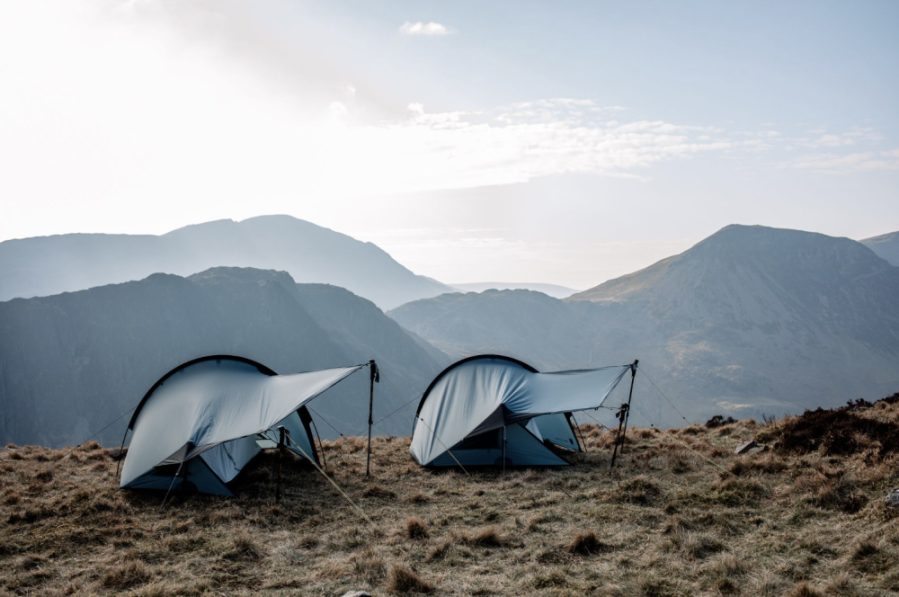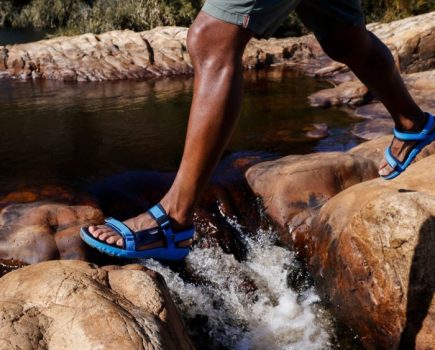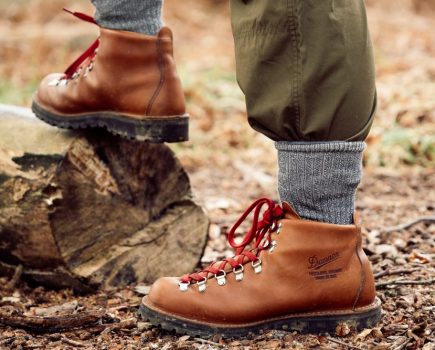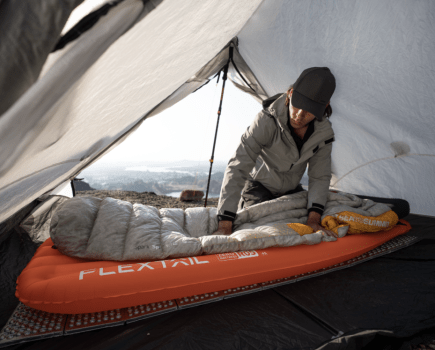When choosing the best backpacking tent for your solo trips, try to think about conditions that it will be used in, and your personal appetite for discomfort! A 1 person tent is like a life support module that keeps the user safe in the mountains. If the weather is bad, it needs to be able to withstand the elements, and ideally, be a comfortable place to spend time.
Main image: A one-person tent is your gateway to independent outdoor adventure | Credit: Wild Country / Terra Nova
The major trade-off is between weatherproofing, strength, and weight. If the budget can stretch a little, it’s possible to find a tent that combines toughness with relatively low weight, but generally, the better it can withstand poor weather, the heavier it’s likely to be.
My first 1 person tent was a real statement of intent for me and a huge step on my journey into the outdoors. It allowed me to carry my own shelter, be self-sufficient and independent, and, excitingly, go wild camping on my own. The tent I chose was cheap, cramped, and quite heavy, but importantly, it was easy to pitch and able to withstand some rough weather. It gave me the freedom I craved.

Fast forward a quarter of a century, and I spend dozens of nights out each year, in all weathers. Liveable space and comfort are much more important to me than they used to be. I’m frequently out in poor weather, and I prefer tents that pitch outer-first or can be pitched as a single unit so that the interior stays dry. It goes without saying that it should be easy to pitch solo. That said, sometimes I simply want to travel light and fast, and if the weather is good enough, it’s enjoyable to use a more minimalist shelter, such as a tarp-tent.
A couple of the tents in this test can be pitched fly-only when used with a groundsheet protector, a wonderful way to sleep out if the weather is fine and biting insects are minimal.
Why you can trust The Great Outdoors
The Great Outdoors is here to help you make the most of your time outside. We have been helping people to explore from sea to summit, valley to mountain top for over 40 years. Our gear tests remain completely impartial. If you are wary of websites that only review brands that advertise with them, or sceptical of social media accounts always singing the praises of their latest freebie, you’ve come to the right place! Our reviews rank #1 for rigour, trustworthiness, and independence, and our gear testing team is the most experienced in Britain. With over 200 years’ experience between us, we are professional mountain leaders and instructors, wildlife photographers and rangers, outdoor authors, guidebook writers and trail addicts. Find out more about how we test.
The best backpacking tents for solo adventures
| Quick List |
|---|
| Best value for three-season use: Wild Country Halny Elite 1 (available from Cotswold Outdoor) |
| Lightest in test: Mountain Laurel Designs SoloMid XL (available from Mountain Laurel Designs) |
| Best for tall people: Vaude Hogan SUL 1-2P (available from alpinetrek.co.uk) |
| Best lightweight living space: Sea to Summit Alto TR1 Plus (available from Wild Bounds) |
| Best for winter: Hilleberg Soulo (available from Valley and Peak) |
Best 3-Season Value
Wild Country Halny Elite 1
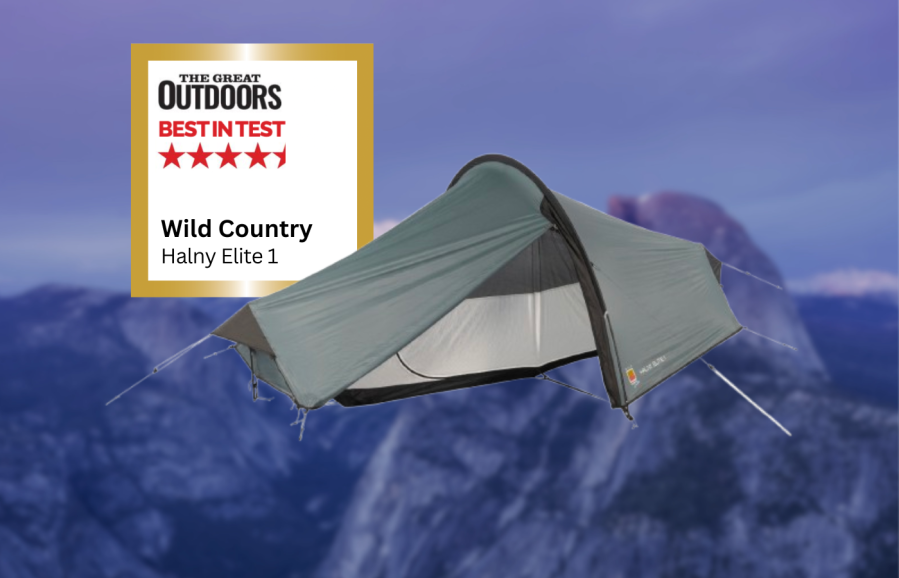
Lucy Wallace’s Best in Test
Overall, the Halny Elite 1 ticks a lot of boxes for anyone looking for a tent suitable for three-season use in the British mountains, in poor weather as well as fine.- tough
- excellent value
- heavier than others
| Quick specs |
|---|
| Price: $370 / £270 (available from Cotswold Outdoor) Weight: 1390g Pitching: Can be pitched as a unit or outer first Flysheet Materials: 20D ripstop recycled and PFC free nylon, with silicone and polyurethane coating and 4,000mm H/H Inner Materials: 20D ripstop PFC free recycled nylon Groundsheet Materials: 70D polyester recycled and PFC free polyurethane coated 5,000mm H/H Poles: 1 x 8.5mm Superflex alloy pole (main, 2 x 8mm Superflex alloy pole (ends) Pegs: 11 x V angle Wild Country Alloy peg Porches: 1 Inner Dimensions: Width 66cm x Height 96cm x Length 220cm www.terra-nova.co.uk |
It’s a single hoop with two strengthening struts at either end, and the entire tent needs tensioning with guy lines to stay pitched. For that reason, it can be tricky to pitch on thin soils where pegs don’t easily hold. This design can be quite flappy in high winds but is reliably strong, with poles and fabric flexing and flapping rather than tearing or snapping.
It can be set up in a couple of minutes as a single unit, with both outer and inner clipped together. I’ve pitched it with confidence at 1000m in gusty 30mph winds with drizzly rain and wasn’t disappointed, passing a comfortable night despite the weather. There are some nice touches. I appreciate the multiple venting options at the head and feet in both the inner and fly sheets.
Overall, the Wild Country Halny Elite 1 ticks a lot of boxes for anyone looking for a tent suitable for three-season use in the British mountains, in poor weather as well as fine.
Read more: Lucy’s full Wild Country Halny Elite 1 review
Trekkertent Saor

David Lintern’s Best in Test
This is a superb shelter for nearly every eventuality. Just remember to buy some pegs to go with it.- Weight
- Space
- Weather resistance
- Price
| Quick specs | |
|---|---|
| Price: $1000 / £732 Weight: 1163g (not including pegs) Pitching: fly first, or as a unit Flysheet: 0.8 oz DCF, 20,000mm Hydrostatic head (silnylon also available) Inner: solid with mesh door, breathable ripstop nylon with DWR (mesh also available) Groundsheet: Silpoly PU 4000, a silicone/PU blend, 4,000mm Hydrostatic head Poles: 2x 8mm DAC Pegs: none supplied Porches: 1 Inner Dimensions: length 265cm, height 90cm, width 85cm www.trekkertent.com |
The Saor is a lightweight dome tent made by Marc at Trekkertent, featuring a Dyneema Composite Fabric (DCF) material that is lightweight, strong, and absorbs little water. It is the newer, easier-to-pitched version of the Saor and is designed for four-season use. The tent has four corners, two poles that cross in the center and slot into corner pockets, and six guying points that can be wrapped around the poles for rigidity or tied to the corner loops at ground level.
The inner, made of solid nylon, hangs in the rear via bungee attachment points and offers ample room for sitting and moving. The vestibule runs the entire length of one side and has a large beak for safe stove setup. The tent has a 2-way, weather-resistant zip for ventilation, and the door can be opened fully or halfway or zipped to create a window.
The Saor is lightweight, strong, and packs down small, making it ideal for gravel bars, coastal camping, and snowy camps. It can sleep two people without an inner, but the inner is a little baggy at the rear, which can be fixed with an extra bungee tie. Overall, I found the Saor a great shelter for various situations, but I recommended you purchase pegs to go with it.
Read more: David’s full Trekkertent Saor review
Lightest in Test
Mountain Laurel Designs SoloMid XL
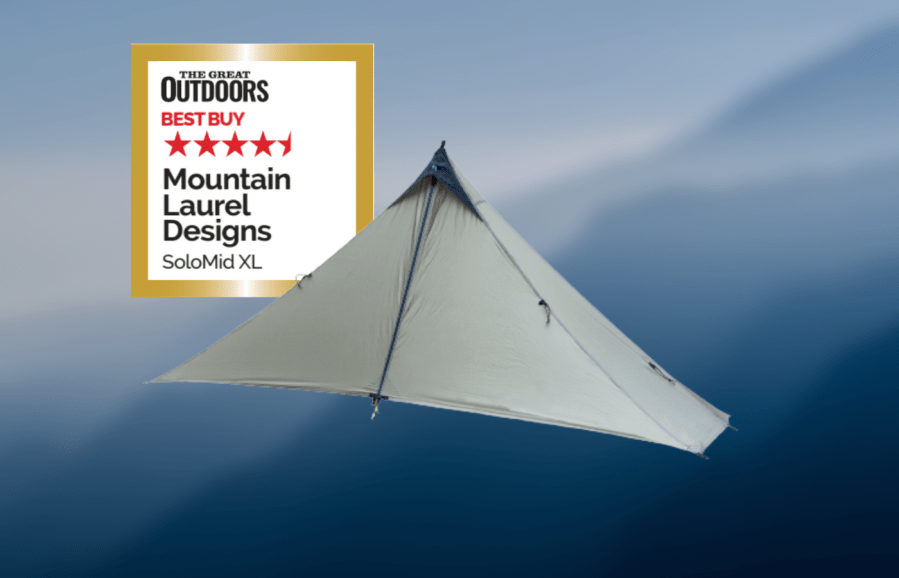
Chris Townsend’s Best in Test
The SoloMid XL has excellent headroom and masses of space for gear storage and cooking under cover. The pole is offset from the centre so there’s more space behind it for sleeping.- Lightweight
- Spacious
- Headroom
- Only available from USA
| Quick specs | |
|---|---|
| RRP: $275/£233, flysheet only Weight: 575g (flysheet only) Flysheet: 20D silpoly, hydrostatic head 5,000+mm Inner: optional silnylon/mesh Innernet tent (311g, $180/£145) Groundsheet: optional silnylon (156g, $75/£60) Poles: trekking pole or UL Carbon Fibre pole (91g, $42/£34) Pegs: not provided, optional MLD Ultimate Stake Set (133g, $42/£34) Porches: 1 with Innernet Dimensions: 280 x 142cm, max. height 140cm |
The SoloMid XL is a pyramid tent that pitches with a trekking pole, made from silpoly (silicone impregnated polyester), a material with ‘functionally comparable’ strength to silnylon. It offers better UV resistance and lower water absorption, making it easier to pitch a silpoly shelter. To pitch the SoloMid XL, a trekking pole set to 140cm is needed, along with eight tent pegs. If you attach guylines to the four tie-outs on the side of the tent, another four pegs are needed. A lightweight carbon fibre pole is available for an extra £34.
I found this tent to have excellent headroom and ample space for gear storage and cooking under cover. The pole is offset from the center, providing more space behind it for sleeping. There is one vent at the tp of the door zip covered by a hood.
The SoloMid XL can be turned into a double-skin tent with MLD’s mesh Innernet, adding 311 grams to its weight. The total weight is around 1020 grams, making it very light for such a roomy shelter.
Read more: Chris’ full review of the Mountain Laurel Designs SoloMid XL
Best for tall people
Vaude Hogan SUL 1-2P
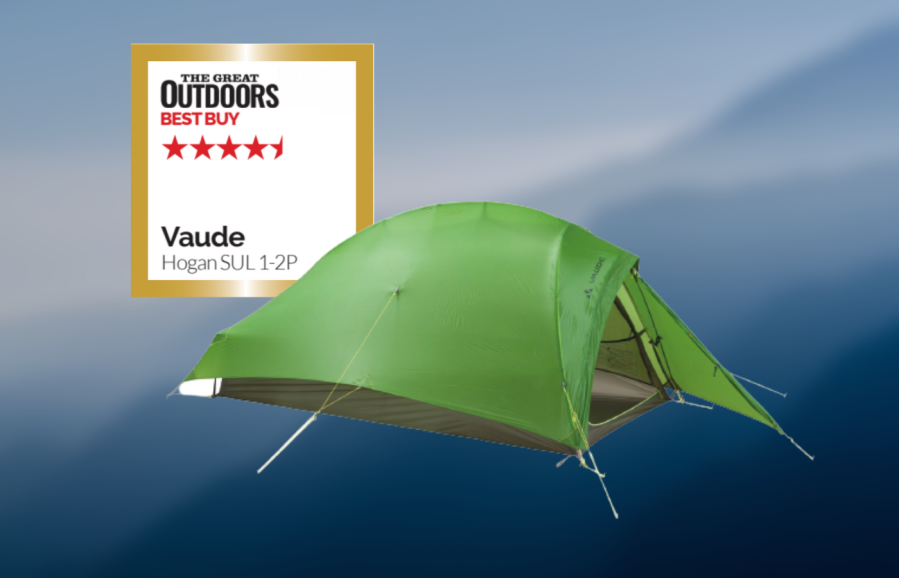
Chris Townsend’s Best in Test
Overall, this is an excellent lightweight tent, a good balance between weight and space. It’s more wind resistant than many of the others tested too.- Wind resistance
- Length
- Groundsheet hydrostatic head could be higher
| Quick specs | |
|---|---|
| RRP: $565.50 / £500 | U.S. shipping charges apply | Available from alpinetrek.co.uk Weight: 2.76 lb. | 1255g Flysheet: silicone nylon, 3000mm HH Inner: nylon/mesh Groundsheet: 30D PU ripstop nylon, 3000mm HH Poles: 8.7mm DAC NFL featherlight Pegs: 10 x 15cm X Porches: x1, 70cm deep Inner dimensions: 235cm x 110/90cm, 95cm high point. |
The Vaude Hogan SUL 1-2P is a versatile tent designed for 1-2 people, offering room and wind resistance. I found it suitable for two smallish people and it would be good for taller individuals due to its longer length. The tent weighs 1255g and features a tripod design with a long pole attached via a hub to two shorter poles that form an arch at the front. Two upright poles at the rear corners lift the fabric and provided me more inner space.
The main pole protrudes beyond the arch to create a larger porch, providing a hood over the top of the outer door zip for ventilation. Double guylines pull out the sides to allow ventilation under the flysheet, but can be pegged closer to the ground in severe weather.
The porch is roomy enough for safe cooking and can be used for solo use. Half or all the porch doors can be opened for good views and easy access. The tent pitches inner first, which I was able to do quickly in raining conditions. The flysheet is triple silicone coated and has taped seams, using a process exclusive to Vaude. The groundsheet has an adequate 3000mm hydrostatic head, though higher would be better.
In summary, the Vaude Hogan SUL 1-2P is an excellent lightweight tent with a good balance between weight and space, making it more wind resistant than other tents I tested.
Read more: Chris’s full Vaude Hogan SUL 1-2P review
Best for Winter
Hilleberg Soulo
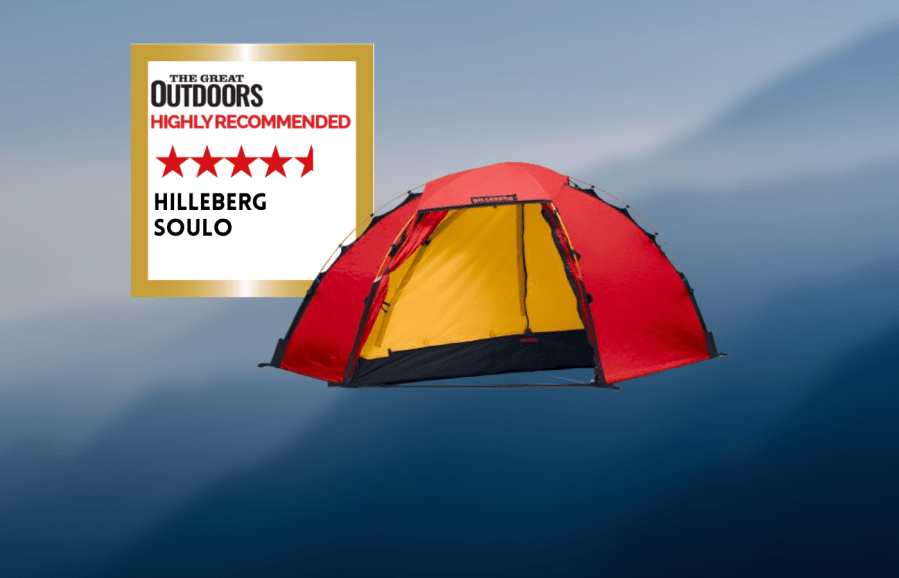
David Lintern Highly Recommends
The Soulo remains one of the most comfortable and secure all weather 1 person shelters I’ve ever used. It pitches easily, provides plenty of sleeping and storage space and sheds weather like a champ.- Generous living space
- Durability
- Weather resistance
- Weight
- Price
| Quick specs | |
|---|---|
| Price: $1,063 / £940 Weight: 2423g Pitching: As a unit, fly first, freestanding Flysheet: Kerlon 1200 – 30 D High Tenacity Ripstop Nylon 66, Hydrostatic Head 5000mm Inner: 30 Denier Ripstop Nylon, DWR. Groundsheet: 70 Denier Nylon, Triple-coated Polyurethane, Hydrostatic Head 15000mm Poles: 3x 9mm Pegs: 12 4” V pegs Porches: 1, 75cm high x 45cm deep Inner Dimensions: length 226cm, 90cm high, width at centre 100cm hilleberg.com/eng/ |
The Hilleberg Soulo is a durable, high-quality freestanding 4 season tent with an exoskeleton design. It features two 9mm poles in pockets around the flysheet, a third pole supporting the vestibule and rear wall, and four corner pegs and 12 guy lines for extra stability. The tent has a detachable roof and a 2-way zip on the flysheet door for a covered top vent, allowing cooking in the vestibule and shelter from windblown rain. The inner has a 2-way zip and a full mesh window for warmth.
I found the living space large due to high walls, with two pockets and tabs for hanging drying lines or torch. The tent is comfortable and easy to stretch out, even for taller individuals. Stuff sacks are oversized, and the guy lines and adjusters are adjustable. The Soulo is easy to use and pack, but it is relatively weighty and bulky. Despite its price, the Soulo remains one of the most comfortable and secure all-weather 1 person shelters I’ve ever used.
Read more: David’s full Hilleberg Soulo review
Terra Nova Southern Cross 1
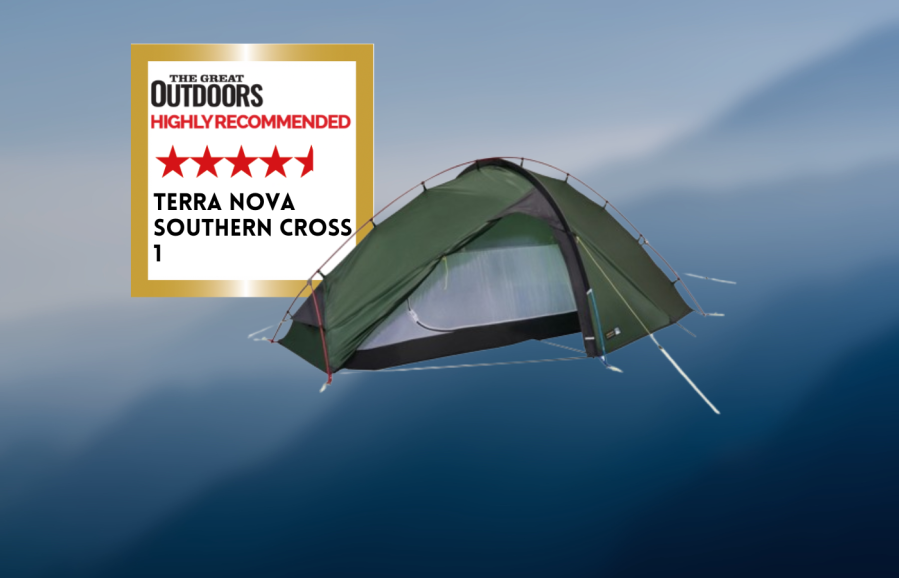
David Lintern Highly Recommends
If you are in the market for a winter capable, 2 skin shelter for British weather, this should be high on your list. At the current sale price, it’s excellent value.- Very durable
- Weather resistant
- Low headroom while lying down
| Quick specs | |
|---|---|
| Price: £700 (only available in the UK & EU) Weight: 1771g Pitching: As a unit, freestanding Flysheet: Watershed 30D Nylon Ripstop Si/Pu, 5000mm Hydrostatic Head Inner: 20D Ripstop Nylon C0, Groundsheet: Waterbloc 70D Nylon PU, 10,000mm Hydrostatic Head Poles: 8.64mm TN Reflex x 2 Pegs: 14, 6” Y shaped Porches: 1, 55 deep x 90cm long x 90cm high Inner Dimensions: Inner 87 wide at centre, 215 long www.terra-nova.co.uk |
The Southern Cross one-person tent, part of the Terra Nova range, is a cross-framed, freestanding shelter designed to withstand most British weather conditions. It features a roomy porch, a 2-way door zip, and six main pegging points for side panels and vents. The inner is solid with a mesh door window and zipper, providing a cosy shelter on breezy nights. The living space is good length and triangle-shaped. I appreciated the storage space at the back and a pocket. The inner is now PFC-free, but the built-in groundsheet remains reassuringly taped and impermeable.
The tent’s design has been finessed since its first iteration, and the reduced scale of single-person tents makes the Southern Cross 1 feel bomber to me. However, I found adjusting the poles and zippers to be tricky, and the poles can be fiddly. Despite these issues, the Southern Cross 1 is a winter-capable, 2-skin shelter for British weather, making it a top choice for those in the market.
Read more: David’s full Terra nova Southern Cross 1 review
Best lightweight living space
Sea to Summit Alto TR1 Plus

Lucy Wallace recommends
In summary, this is a pricey, clever, luxurious tent, ideal for three-season use, if not for strong winds.- excellent liveable space
- steep sides catch the wind
| Quick specs |
|---|
| Price: $670 / £490 (available from Wild Bounds) Weight: 1210g Pitching: semi freestanding, inner first, although fly can be pitched independently with an additional footprint Flysheet Materials: Silicone and Polyether Polyurethane coated 15D nylon with H/H of 1200mm Inner Materials: 20D ripstop nylon Groundsheet Materials: 20D nylon with 2500mm H/H Poles: Aluminium DAC Featherlite NFL TH72M, 8.7 and 9.5mm Pegs: 11 anodised aluminium Y-shaped Ground Control Light pegs Porches: 1 Inner Dimensions: Width 65cm (head) 60cm (feet)107cm (middle) x length 215cm x height 105cm seatosummit.co.uk |
It’s packed with clever features, but the headline is the hubbed pole design with a central cross-piece that points upward in a V-shape, maximising headroom and creating a luxuriously liveable space. The tent is most easily pitched inner-first and can be erected in a few minutes, though with practice it’s possible to pitch the outer first in wet weather. The outer can also be used alone as a single-skin shelter for ultralight trips.
The pack size isn’t particularly small, but each part has its own stuff sack, which can be strapped together or separated. This is useful for distributing weight when space is at a premium. The tent’s stuff sacks double as clip-in interior pockets (there’s also a mesh pouch), and the pole bag clips to the ceiling so that with a head torch inside, it creates a soft strip-light effect. This is fun, though slightly gimmicky, and I’d have preferred larger stuff sacks, as these are a tight fit.
The materials are lightweight, but the tent feels well thought-out and built to last. Sea to Summit recommend using it with a groundsheet protector, which costs an additional £45. In summary, this is a pricey, clever, luxurious tent, ideal for three-season use, if not for strong winds.
Read more: Lucy’s full Sea to Summit Alto TR1 Plus review
Exped Mira 1 HL

Lucy Wallace Recommends
If weight is your top priority, the Exped Mira 1 HL wins, even if it’s slightly less luxurious.- very lightweight
- narrow, mesh inner
| Quick specs |
|---|
| Price: $399.95 to $499.95 / £580 (available from Exped) Weight: 1089g Pitching: inner first, although fly can be pitched on its own with additional groundsheet protector Flysheet Materials: 15D ripstop nylon with silicone and polyurethane coating with1500mm H/H Inner Materials: 15D ripstop nylon with 15D No-See-Um mesh. DWR C6 treatment. Groundsheet Materials: 20D ripstop nylon, silicone and polyurethane coating 1500mm H/H Poles: DAC Featherlite NFL TH72M 8.7mm Pegs: 10 V pegs Porches: 1 Inner Dimensions: Width 70cm x length 215 cm x height 105cm expeduk.com |
The hubbed design pitches inner first but with a horizontal crosspiece rather than a V-shape. As a result, I found it easy to sit up inside.
The footprint is a narrow rectangle but offers good length. The tent has one main porch, large enough for a rucksack, boots, and a stove. There’s also a second vestibule, accessible via a long zip on the opposite side, increasing external storage space. I think this additional space would be better utilised if incorporated into the main body of the tent to improve internal living space.
Due to the lightweight materials, Exped recommend using this protector anyway, which adds 175g to the setup. Overall, this tent feels like it may struggle under heavy use in mixed weather, particularly in strong wind. The mesh inner makes it more suitable for warmer nights. If weight is your top priority, the Exped Mira 1 HL wins, even if it’s slightly less luxurious.
Read more: Lucy’s full Exped Mira 1 HL review
Hilleberg Enan
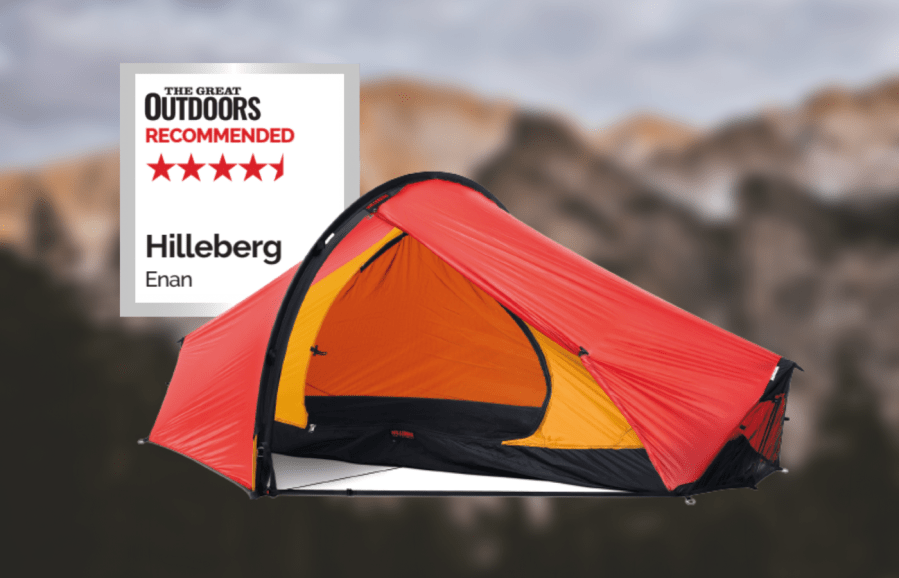
Chris Townsend Recommends
As a lightweight solo three-season tent the Hilleberg Enan is hard to fault. I think it’s superb. However, it is very expensive.- Low weight
- Porch
- High hydrostatic
- Ventilation
- Expensive
| Quick specs | |
|---|---|
| RRP: $720/£750 | Available from Alpine Trek Weight: 1100g Flysheet: 10D silicone nylon, 5000mm hydrostatic head Inner: 10D ripstop nylon/mesh Groundsheet: 70D PU coated nylon, 15000mm hydrostatic head Poles: 9mm SAC NSL Pegs: 8 x 15cm Y Porches: 1, max depth 75cm Inner Dimensions: 215 x 95cms widest, 60cms ends, 93cms max. height |
The Hilleberg Enan is a lightweight three-season tent with a mesh inner door and single short poles at each end. It weighs 1100g and has a flysheet made of 10D silicone nylon with a 5000mm hydrostatic head. The groundsheet is 70D PU coated nylon with a 15000mm hydrostatic head, making it waterproof for a long time.
The flysheet ends are made of mesh with roll-down panels of solid fabric available if needed, and the top of the flysheet door can be left undone as a high-up vent. The inner has plenty of space for gear storage and headroom, and the doors roll back neatly. The flysheet fabric rustled in the wind, but this has eased off with use and doesn’t stop sleeping. I think the Hilleberg Enan is a superb lightweight solo three-season tent, but it’s expensive.
Read more: Chris’ full review of the Hilleberg Enan.
MSR Hubba NX Solo
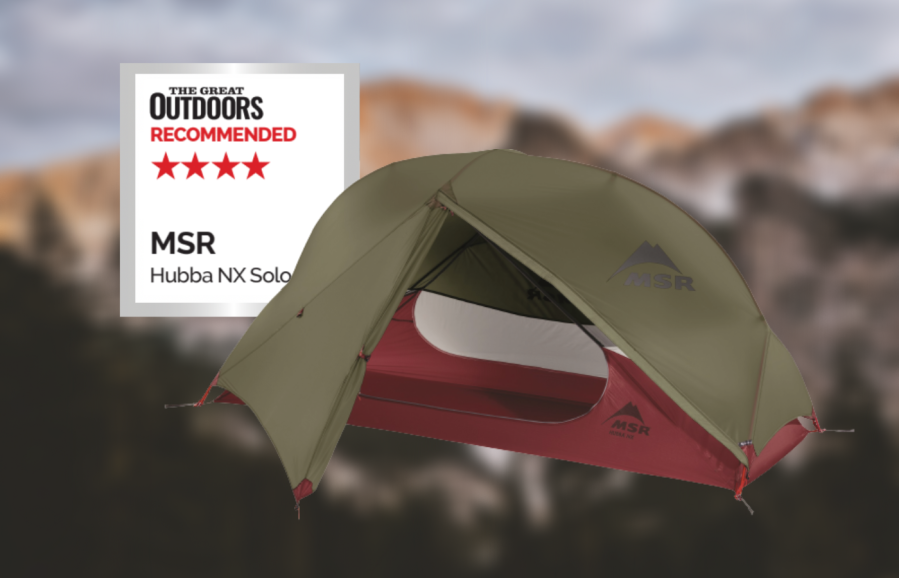
Chris Townsend Recommends
The Hubba NX Solo is lightweight, especially given the space inside. It resists winds well and is a good three-season tent.- Lightweight
- Roomy
- Big porch
- Flysheet doesn’t come right down to the ground
| Quick specs | |
|---|---|
| RRP: $533/£570 | Available from Alpine Trek Weight: 1.26kg Flysheet: silicone/PU 20D ripstop nylon, 1200mm hydrostatic head Inner: ripstop nylon/nylon micromesh Groundsheet: 30D PU ripstop nylon, 3000mm hydrostatic head Poles: DAC Featherlite NFL Pegs: 9 x 16cm MSR Needle Porches: 1, max. depth 76cm Inner Dimensions: 216 x 76cm, 91cm high point |
The MSR Hubba NX Solo is a lightweight, three-season tent with a pole with hub connections to the Y sections at the end and the ridge. It features a flysheet with a 1200mm hydrostatic head, ripstop nylon/nylon micromesh, and a 30D PU ripstop nylon groundsheet. The flysheet doesn’t come all the way down to the ground, but the groundsheet has high walls and no dampness.
I found the inner and porch are roomy, with headroom good for six-footers. The groundsheet is rectangular, providing equal sleeping space. The inner has solid fabric above the groundsheet, wide mesh walls, and solid fabric again as the roof. The flysheet zip can be left open at the top, and the flysheet has a closable vent at the back. The tent is lightweight, resists winds, and offers maximum views, ventilation, and access.
Read more: Chris’ full review of the MSR Hubba NX Solo.
Terra Nova Laser Compact AS
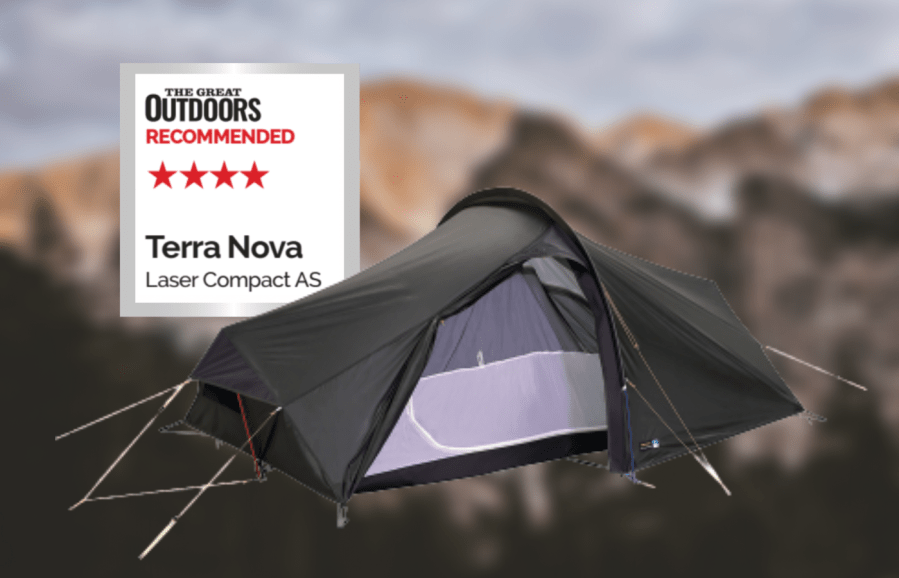
Chris Townsend Recommends
As a winter tent, the Laser Compact AS is a good choice. The design is a bit heavy for summer unless you plan on high-level camping in storms.- Weather resistance
- Roomy inner
- Tough Groundsheet
- Shallow porch
- Quite heavy
- Expensive
| Quick specs | |
|---|---|
| RRP: £690, only available in the UK & EU | Available from Terra Nova Weight: 1780g Flysheet: PFC-free 30D nylon ripstop, hydrostatic head 3000mm Inner: PFC-free 30D ripstop nylon Groundsheet: 70D nylon PU, hydrostatic head 10000mm Poles: Terra Nova Reflex Pegs: 14 x 18cm alloy Y Porches: 1, max depth 40cm Inner Dimensions: 92 x 110 x 92cm |
Unlike most of the 1 person tents I have reviewed, the new Terra Nova Laser Compact AS is designed for year-round use – the AS stands for All Season. That means it’s built with heavy-duty materials including a groundsheet with a very high hydrostatic head and is designed to repel wind and snow.
It also has extra headroom and living space over the other Laser models for comfort in cold weather. The penalty for this is extra weight. It’s also expensive.
Read more: Chris’ full review of the Terra Nova Laser Compact AS
Sierra Designs High Route 3000 1

Chris Townsend Recommends
The Sierra Designs High Route 3000 1 is a great choice for midge season use, with the inner used only in midge season.- Pitches with trekking poles
- Very roomy
- makes a good tarp
- Light
- Minimal porches
| Quick specs | |
|---|---|
| RRP: $300 | £285 | Available from wildbounds.com Weight: 2.22 lb. | 1010g Flysheet: 20D nylon ripstop silicone/PU, 3000mm HH Inner: 20D nylon ripstop silicone/15D nylon mesh Groundsheet: 30D nylon ripstop, 3000mm hydrostatic head Poles: n/a, 2 trekking poles needed Pegs: 9 x 15cm Y Porches: x2, 28cm deep Inner dimensions: 259cm x 107ccm, 114cm high in centre. |
The Sierra Designs High Route 3000 1 is a European version of the one-person tent, launched in the USA a few years ago. It features a hydrostatic head of the flysheet and groundsheet, increasing durability and waterproofness. The tent’s size and design remain the same, but the fabric changes add 130 grams to the weight. The tent is designed for use as a tarp or tent, pitching with trekking poles. The inner is mostly mesh with solid panels at each end, and it clips onto the outer.
The asymmetric shape of the tent allows for a long offset ridge and vertical side walls, providing more space than standard ridges. The tent has a spacious inner with the best headroom, but I found the two porches are small, with one designed for storage and the other for ventilation. The main door can be pegged out as an awning for a sheltered cooking area and good ventilation. Wind resistance is reasonable, but the large panels can flap in strong winds.
Read more: Chris’s full Sierra Designs High Route 3000 1 review
Vango Heddon 100
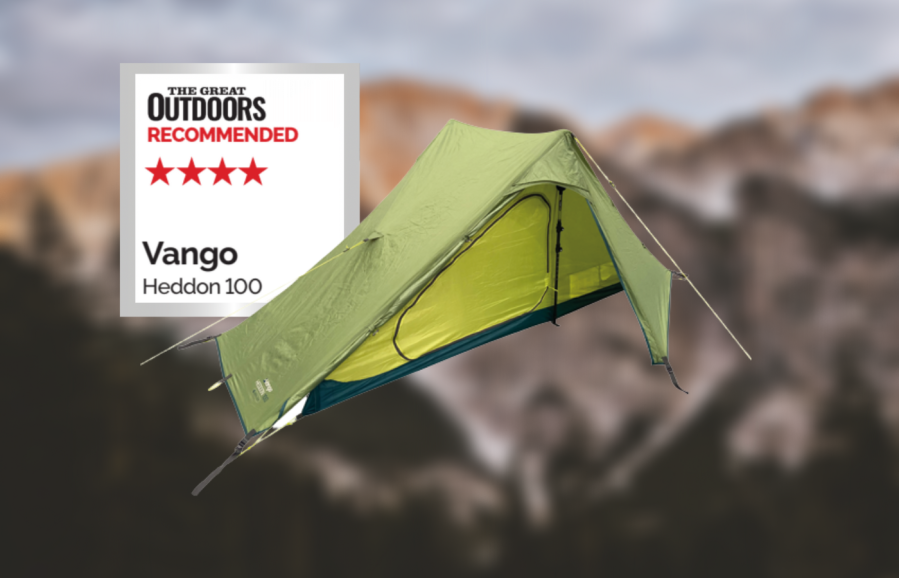
Chris Townsend Recommends
The Heddon 100 is good value for money and should last well. It stands up to strong winds well and is comfortable to live in on long cold winter nights.- Pitches with trekking poles
- Tough groundsheet
- Roomy
- Low cost
- Not that light
| Quick specs | |
|---|---|
| RRP: £285 | from vango.co.uk Weight: 3.68 lb. | 1670g Flysheet: recycled 70D polyester, 3000mm HH Inner: polyester Groundsheet: 70D polyester, 6000mm HH | Poles: n/a, 2 trekking poles needed Pegs: 13 x 18cm hook Porches: x2, 65cm deep Inner dimensions: 220cm x 85/75cm, 90cm high point |
For a trekking pole tent the weight is on the high side. Against that, the fabrics are substantial, especially the groundsheet, which has a high hydrostatic head, and there is plenty of room. The inner is solid too, which adds a little weight. This is a tent designed for wet and cool British weather. The flysheet has taped seams and is made of recycled polyester. The heavier fabric is also reflected in the cost, which is low.
I found the Vango Heddon 100 easy to pitch as a unit. The inner can be detached, and the flysheet used on its own. This cuts the weight and makes for a spacious shelter. Ventilation is limited. There’s a hood over the flysheet door so the two-way zip can be left open at the top without letting rain in and a similar hood on the other side, covering a small mesh vent. The porches are roomy for me.
The Heddon 100 is good value for money and I believe it should last well. It stands up to strong winds well and is comfortable to live in on long cold winter nights. A lighter weight version would be nice, but this is an excellent choice if weight is less important to you.
Read Chris’s full Vango Heddon 100 review.
Testing conditions
In this article, Lucy Wallace, Chris Townsend and David Lintern reveal the results of their solo tent testing. The majority of options are 1 person designs though there are a couple of two-person options that will be light and packable enough for solo trips too.
Lucy Wallace
The tents were tested over several wild camps in mixed springtime conditions in 2025. This included some rough, wet and windy nights out. Weights supplied were measured on Lucy’s home digital scales, and include the entire tent, poles, pegs and stuff sacks as packed.

Chris Townsend
Chris tested these backpacking tents in the Scottish Highlands, mostly the Cairngorms, in 2023. Sites were both high and low level and at times the tents were subjected to more severe weather than they are designed for. Note: weights are for the tent complete with stuffsacks.
David Lintern
David tested these tents between summer 2023 and spring 2024, meaning that all were tested to their design limits and in many cases, well beyond! They were used across the Scottish Highlands everywhere from riverside and woodland camps to mountain tops, in high winds, extreme cold, rain and snow. All weights are from David’s digital scales and include complete units including stuff sacks and pegs where supplied. Measurements were made with a tape measure in the field.

Key features for one-person backpacking tents: How to choose a solo tent
These are some of the crucial details to look for when you’re shopping around for the right lightweight one-person backpacking tent for solo adventures.
Materials
Silicone coated fabrics are very light and durable. PU coated nylon or polyester is heavier and less durable but costs less. The seams on silicone nylon tents aren’t usually taped – silicone is very slippery – so some makers treat the nylon with silicone on the outside and PU on the inside so the seams can be taped.
Breathable nylon or polyester resists drips from condensation and keeps out breezes. In warm weather optional mesh doors are useful. Mesh inners are cooler and airier but not as warm, especially in a breeze, and condensation can drip through unless the mesh is very fine.
You’ll find more information on the different types of tent fabrics and how to maintain them in this guide that looks at how to clean a tent.
Groundsheets should be made from heavier fabrics than flysheets and have a higher hydrostatic head (the measure of how much water pressure can be applied before a material leaks). Some makers recommend using an optional footprint under light groundsheets. These add weight and cost.

Inner Dimensions
The inner should be long enough that your sleeping bag doesn’t push against the end. There should be room for a full-length, full-width (c100cm) sleeping mat without it touching either end. Headroom should be enough that you can sit up comfortably at the highest point of the inner – for me that means a minimum of 90cms.
Poles and pegs
Poles should be easy to attach. Backpacking tents with sleeves should slide in place without sticking. If the poles are different lengths, they and the attachment points should be colour-coded, so the right pole goes in the right place.
It’s useful to have a mix of different types; thin ones for hard ground and wider ones for soft ground. The ones for key pegging points and guylines should be 14-15cms long. With most backpacking tents adding a few different pegs to those supplied is advisable both for different types of ground and in case of loss.
Guylines
Guylines are the key to stability in strong winds. Extra guylines are useful in a big storm. Many tents have attachment points for these.
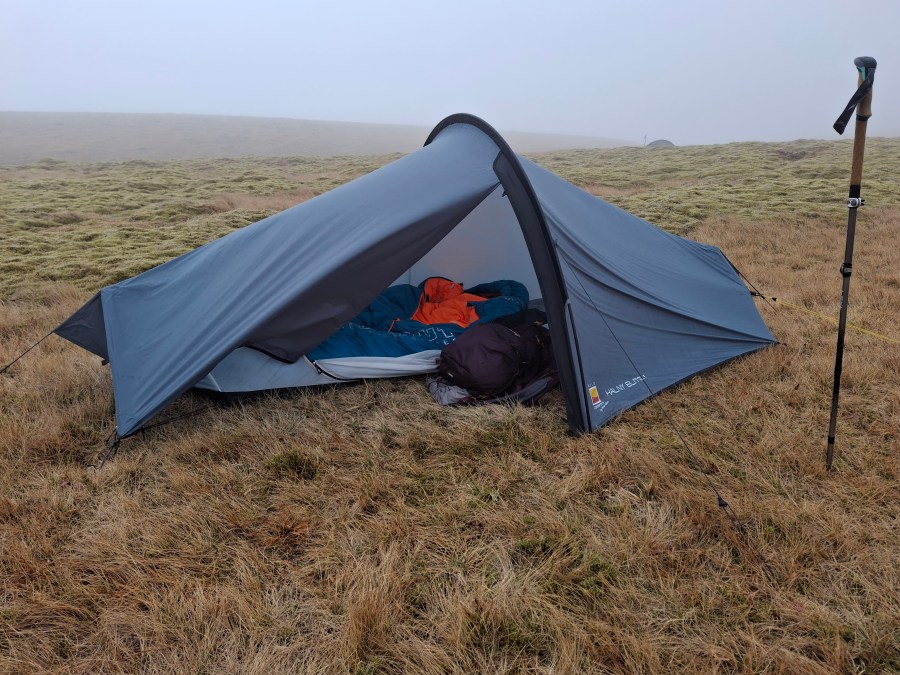
Porches and doors
The porch should be big enough for safe cooking and for storing hiking boots, wet gear and packs. With some tents porch space can be increased by adjusting the position of the inner or by using a guyline to peg out one side of the door as an awning.
Flysheet doors that can be opened in several ways are the most versatile. In good weather you can open them fully for easy access and good views. Unlike two person tents, most one person tents will only have one door and porch.
Ventilation
Protected vents or upper door zips that can be left open in all but the worst weather can reduce the amount of condensation that builds up in humid weather. Only close vents when you really must to prevent rain entering.
Pitching
Some tents pitch inner first, some flysheet first or as a unit. The first gives a taut inner but speed is needed in rain. Flysheet and unit pitching keeps the inner dry, but it can be hard to tension the inner. Whatever the method it’s best to practise pitching before taking a tent on a trip.

